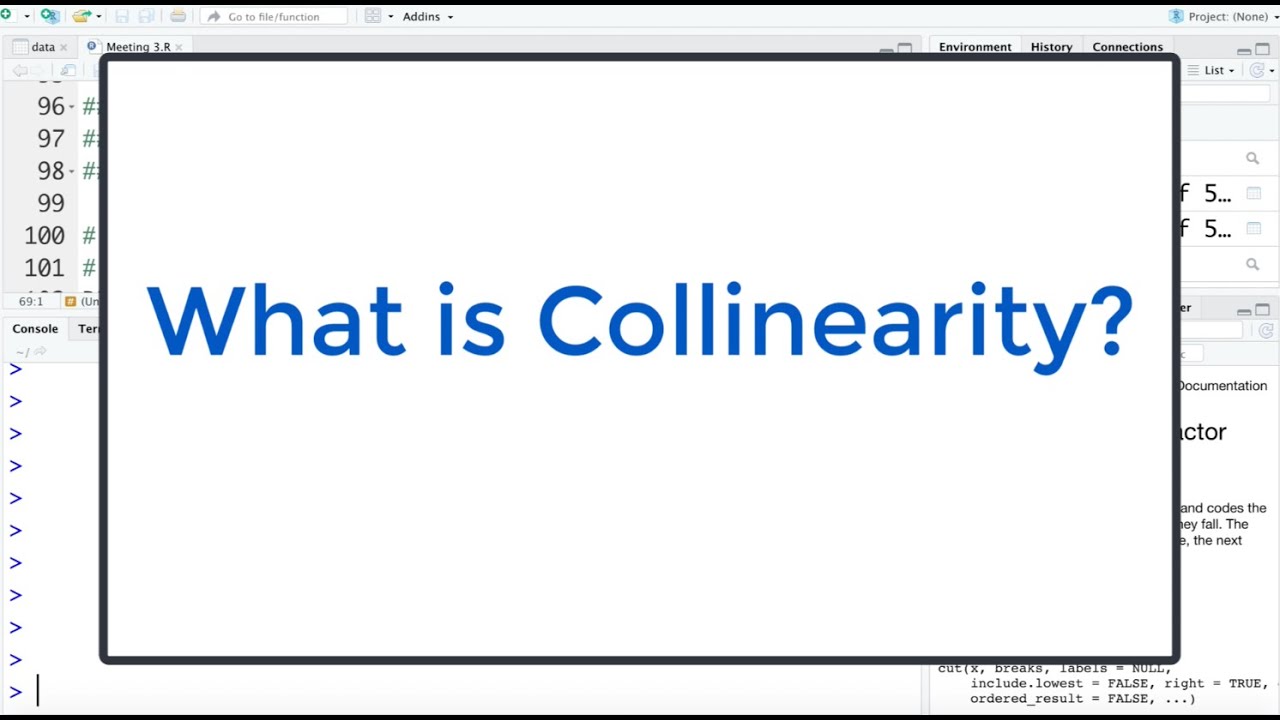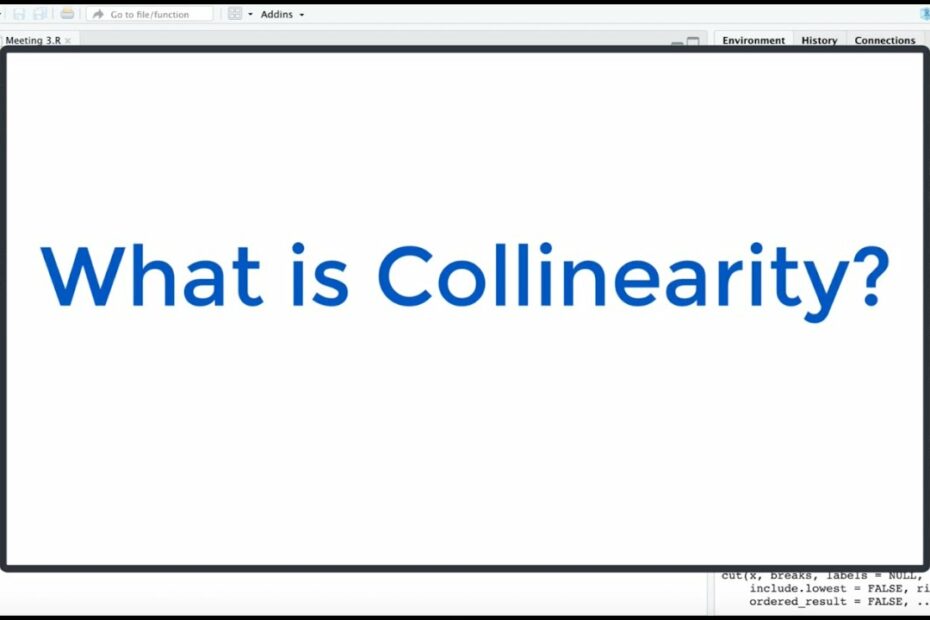Let’s discuss the question: how to check collinearity between categorical variables in r. We summarize all relevant answers in section Q&A of website Achievetampabay.org in category: Blog Finance. See more related questions in the comments below.

How do you test for collinearity with categorical variables?
For categorical variables, multicollinearity can be detected with Spearman rank correlation coefficient (ordinal variables) and chi-square test (nominal variables).
Can you have collinearity between categorical variables?
Here is an example for @Alex demonstrating highly collinear data and the output of vif in that situation. Generally you hope to see variance inflation factors below 10. Categorical variables cannot be colinear. They do not represent linear measures in Euclidean space….
3.6 Collinearity in R: Checking For Collinearity In R
Images related to the topic3.6 Collinearity in R: Checking For Collinearity In R

How do you check for collinearity in R?
- Review the correlation matrix for predictor variables that correlate highly.
- Compute the Variance Inflation Factor (henceforth VIF) and the tolerance statistic.
- Compute Eigenvalues.
Can we do VIF for categorical variables?
VIF cannot be used on categorical data.
What is GVIF R?
More generally generalized variance-inflation factors consist of the VIF corrected by the number of degrees of freedom (df) of the predictor variable: GVIF = VIF[1/(2*df)] and may be compared to thresholds of 10[1/(2*df)] to assess collinearity using the stepVIF function in R ( see here).
What is chi-square test for categorical data?
The Chi-Square Test of Independence determines whether there is an association between categorical variables (i.e., whether the variables are independent or related). It is a nonparametric test. This test is also known as: Chi-Square Test of Association.
How do you test for collinearity in logistic regression?
One way to measure multicollinearity is the variance inflation factor (VIF), which assesses how much the variance of an estimated regression coefficient increases if your predictors are correlated. A VIF between 5 and 10 indicates high correlation that may be problematic.
How do you test for multicollinearity?
A simple method to detect multicollinearity in a model is by using something called the variance inflation factor or the VIF for each predicting variable.
What is dummy trap?
The Dummy variable trap is a scenario where there are attributes that are highly correlated (Multicollinear) and one variable predicts the value of others. When we use one-hot encoding for handling the categorical data, then one dummy variable (attribute) can be predicted with the help of other dummy variables.
What is Farrar Glauber test?
Farrar–Glauber test: If the variables are found to be orthogonal, there is no multicollinearity; if the variables are not orthogonal, then at least some degree of multicollinearity is present.
Is collinearity the same as correlation?
Correlation refers to an increase/decrease in a dependent variable with an increase/decrease in an independent variable. Collinearity refers to two or more independent variables acting in concert to explain the variation in a dependent variable.
Testing for Multicollinearity in R
Images related to the topicTesting for Multicollinearity in R

How do you deal with collinearity in R?
There are multiple ways to overcome the problem of multicollinearity. You may use ridge regression or principal component regression or partial least squares regression. The alternate way could be to drop off variables which are resulting in multicollinearity. You may drop of variables which have VIF more than 10.
How can we prevent multicollinearity in categorical data?
To avoid or remove multicollinearity in the dataset after one-hot encoding using pd. get_dummies, you can drop one of the categories and hence removing collinearity between the categorical features. Sklearn provides this feature by including drop_first=True in pd. get_dummies.
What is collinearity in regression?
collinearity, in statistics, correlation between predictor variables (or independent variables), such that they express a linear relationship in a regression model. When predictor variables in the same regression model are correlated, they cannot independently predict the value of the dependent variable.
Can you center categorical variables?
In any case, it makes no sense to scale and center binary (or categorical) variables so you should only center and scale continuous variables if you must do this.
What is the difference between VIF and GVIF?
The vif commands from the rms and DAAG packages produce VIF values, whereas the other two produce GVIF values. The GVIF is calculated for sets of related regressors such as a for a set of dummy regressors. For the two continuous variables TNAP and ICE this is the same as the VIF values before.
What is the cutoff for VIF?
Variance Inflation Factor (VIF)
The generally accepted cut-off for VIF is 2.5, with higher values denoting levels of multicollinearity that could negatively impact the regression model.
Does multicollinearity effects logistic regression?
Multi- collinearity may also result in wrong signs and magnitudes of logistic regression coefficient estimates, and consequently incorrect conclusions about relationships between explanatory and response variables.
How do you test the significance between two categorical variables?
The Pearson’s χ2 test is the most commonly used test for assessing difference in distribution of a categorical variable between two or more independent groups. If the groups are ordered in some manner, the χ2 test for trend should be used.
How do you know if two categorical variables are significantly different?
This test is used to determine if two categorical variables are independent or if they are in fact related to one another. If two categorical variables are independent, then the value of one variable does not change the probability distribution of the other.
How does one test for an association between two categorical variables based on data in a two way table?
We use the chi-square (χ2 ) test to assess the null hypothesis of no relationship between the two categorical variables of a two-way table. To test this hypothesis, we compare actual counts from the sample data with expected counts, given the null hypothesis of no relationship.
R tutorial for 2-2 Examining Relationships Between Two Categorical Variables
Images related to the topicR tutorial for 2-2 Examining Relationships Between Two Categorical Variables

Can we check VIF for logistic regression?
Values of VIF exceeding 10 are often regarded as indicating multicollinearity, but in weaker models, which is often the case in logistic regression; values above 2.5 may be a cause for concern [7]. From equation (2), VIF shows us how much the variance of the coefficient estimate is being inflated by multicollinearity.
What is collinearity test?
The collinearity diagnostics confirm that there are serious problems with multicollinearity. Several eigenvalues are close to 0, indicating that the predictors are highly intercorrelated and that small changes in the data values may lead to large changes in the estimates of the coefficients.
Related searches
- how to check multicollinearity for categorical variables in python
- multicollinearity categorical variables logistic regression
- how to check multicollinearity for categorical variables in stata
- how to check multicollinearity for categorical variables in spss
- correlation between categorical variables in r
- multicollinearity between categorical and continuous variables
- how to check multicollinearity for categorical variables in sas
- correlation matrix for categorical variables in r
Information related to the topic how to check collinearity between categorical variables in r
Here are the search results of the thread how to check collinearity between categorical variables in r from Bing. You can read more if you want.
You have just come across an article on the topic how to check collinearity between categorical variables in r. If you found this article useful, please share it. Thank you very much.

